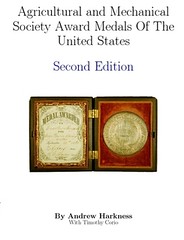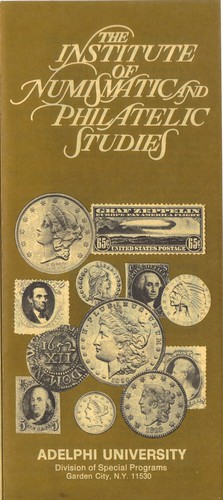
About UsThe Numismatic Bibliomania Society is a non-profit organization promoting numismatic literature. For more information please see our web site at coinbooks.org SubscriptionsThose wishing to become new E-Sylum subscribers (or wishing to Unsubscribe) can go to the following web page link MembershipThere is a membership application available on the web site Membership Application To join, print the application and return it with your check to the address printed on the application. Membership is only $15 to addresses in the U.S., $20 for First Class mail, and $25 elsewhere. For those without web access, write to: David M. Sundman, Secretary/TreasurerNumismatic Bibliomania
Society AsylumFor Asylum mailing address changes and other membership questions, contact David at this email address: dsundman@LittletonCoin.com SubmissionsTo submit items for publication in The E-Sylum, just Reply to this message, or write to the Editor at this address: whomren@coinlibrary.com
BUY THE BOOK BEFORE THE COINYou won't regret it! |
- WAYNE'S WORDS: THE E-SYLUM NOVEMBER 28, 2010
- NUMISMATIC PUBLISHER AL HOCH, 1935-2010
- AOL: ABANDON HOPE ALL YE WHO SUBSCRIBE HERE
- UPDATED AMERICAN NUMISMATIC BIOGRAPHIES AVAILABLE ON NBS WEB SITE
- LAKE BOOKS' 105TH MAIL-BID SALE CLOSES NOVEMBER 30, 2010
- KOLBE & FANNING PUBLIC AUCTION SALE 120 JANUARY 8, 2011
- NEW EDITION: AGRICULTURAL AND MECHANICAL SOCIETY MEDALS OF THE U.S.
- NEW BOOK: MERCHANTS MAKING MONEY, 2011 EDITION
- BOOK REVIEW: THE ENCYCLOPEDIA OF ROMAN IMPERIAL COINS, SECOND EDITION
- PRINCETON 'MONEY ON PAPER' EXHIBIT LECTURE DECEMBER 12, 2010
- MORE ON THE WHITMAN 'VAULT' BOOKS
- NUMISMATIC VOCABULARY: ANAGLYPTOGRAPHY
- MORE ON FRENCH-ENGLISH NUMISMATIC TERMS
- MORE ON THE LOVETT TOKENS AND MEDALS WEB SITE
- ADELPHI UNIVERSITY NUMISMATIC PROGRAM BROCHURE
- LOUIS ELIASBERG AND THE STACK'S H.R. LEE SALE
- MORE ON VIETNAMESE NGOC HA GOLD WAFERS
- NOTES FROM E-SYLUM READERS: NOVEMBER 28, 2010
- QUERY: TRANSFERRING AUDIO FROM MAGNETOPHONE RECORDINGS
- QUERY: SABINE PASS MEDAL COPIES
- THE WHERE'S GEORGE VIKING SHIP
- NEW COINS FROM LATVIA AND FRANCE
- ARTICLE HIGHLIGHTS RARE OXFORD 1066 PENNY
- MORE ON THE FORGED ROMAN SILVER DENARIUS
- MILITARY WIDOW SAYS HUSBAND'S MEDALS WERE CREMATED
- READER CRACKS BOOK'S RIDDLE, LOCATES HIDDEN COIN
- FEATURED WEB SITE: PAPER MONEY OF ENGLAND AND WALES
WAYNE'S WORDS: THE E-SYLUM NOVEMBER 28, 2010

We have no new email subscribers this week. We have 1,393 email subscribers, plus 101 followers on Facebook, including Stuart Strickland and Kevin Stroud.
This week we open with word of the passing of numismatic publisher Al Hoch, and an update on the problems several readers are having with their AOL email service. In other NBS news, Pete Smith has made a new update of his American Numismatic Biographies available on the NBS web site. Next, we have updates from literature dealers Fred Lake and Kolbe & Fanning.
Other topics this week include announcements of two new numismatic books, a review of the Encyclopedia of Roman Imperial Coins, Second Edition, the Adelphi University numismatic program, and Sabine Pass medal copies.
To learn about other Whitman Vault Books, a coin containing a piece of amber, an author's hidden coin mystery, Vietnamese gold wafers and anaglyptographic illustrations, read on. Have a great week, everyone!
Wayne Homren
Numismatic Bibliomania Society
NUMISMATIC PUBLISHER AL HOCH, 1935-2010
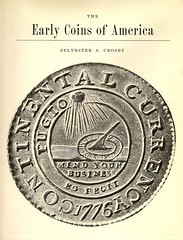
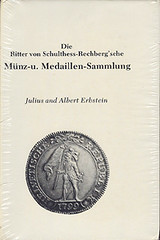
John W. Adams writes:
It sounds like Al's time had come but, nonetheless, his passing is a huge loss to the hobby. His immense intellect embraced all facets of the hobby, while including profound knowledge of many specialties. For those not familiar with Al's Quarterman Publications, the titles he selected for re-printing brought the great classics into our libraries at an affordable price. The quality and care with which he executed each project did full justice to the rare original.
Whether we choose to admit it, collecting is a low grade form of greed. Al was the exception - he had no greed, just reverence for the past, abundant curiosity and a willingness to share his knowledge with others.
Al's son Alan Hoch provided this obituary:
Alfred D. Hoch, 75, of Lexington, passed away peacefully Thursday, November 25th after a long illness. Born January 31st 1935 in Philadelphia, son of Alfred and Frieda (Heurfeld) Hoch. Proud graduate of MIT class of 1957 with a BS in Mechanical Engineering.
Al had national top secret security clearance at the Draper Laboratory in Cambridge where he worked on inertial navigation systems. Among other projects, Al worked on the Apollo project and aided in the design of the navigation system for the Polaris ballistic missile.
He founded Quarterman Publications, a boutique publishing company which has provided generations of advanced collectors and curators with access to high quality reprints of scarce definitive reference works in various collecting fields such as colonial coins, medals, stamps, civil war tokens, American political badges and ribbons, and early coins from various countries.
Al was himself a dedicated and lifelong collector of coins, tokens, and ephemera, and became an acknowledged authority on vintage posters and antique paper Americana in his later years. Formerly of Lincoln, MA, Al recently received a lifetime achievement award from the American Numismatic Society for his scholarly contributions in the field of numismatics.
Al will be remembered as a gentle man with a quirky sense of humor and a love of chocolate, but mostly for the selfless devotion to his children, which he considered his proudest achievement in life. Al is survived by three sons, Alan Hoch of Groton, David Hoch of Belmont, Jon Hoch and his wife Carey of Lincoln, and his daughter Carole Lee and her husband John de Jong of Weston. He also leaves seven grandchildren: Nick, Lily, and Emily Hoch of Groton, Jack and Sam de Jong of Weston, and Daniel and Matthew Hoch of Lincoln. Memorial service will be private.
Dave Schenkman adds:
We were friends for many years, my wife and I still remember the time he stayed at our house, about thirty years ago. I compiled the price guides for three of his books.
AOL: ABANDON HOPE ALL YE WHO SUBSCRIBE HERE
Tom Mulvaney writes:
 For about a month now, I have not be able to open the weekly email version of The E-Sylum, which is sent on Sunday nights. I get a message stating "Delivery Error, Try again later". "Later" never comes and I just can't get it open...
For about a month now, I have not be able to open the weekly email version of The E-Sylum, which is sent on Sunday nights. I get a message stating "Delivery Error, Try again later". "Later" never comes and I just can't get it open...
Perhaps there is a problem with AOL. I would like you to try sending it to an alternate email address I have.
Howard Daniel writes:
I read about your troubles with AOL. You are not the only one having this problem. If you contact James Tichacek, he can fill you in on his problems with AOL when sending out his veteran's newsletter all over the world. I can tell you now the only solution is for the people with AOL addresses to get another one (such as Yahoo or Hotmail) to receive your missive.
Lt. James "EMO" Tichacek, USN (Ret), Editor/Publisher of the RAO Bulletin writes:
Their system is set up to discourage anyone from talking to them on the issue. I fought AOL for over five years and finally gave up.
They received an industry award about seven years ago for being the best server on eliminating spam from their customer's mailboxes. Shortly thereafter my problems with them began. They apparently did not want to lose this title so they set their spam filters to be extremely restrictive on what they will allow to pass them. As a result about 3-4 times a year I would have a large number (thousands) of their users having their Bulletin blocked.
After much attempted communication each time from hundreds of their users to AOL complaining about the blockage the problem would go away in about six weeks only to reappear a few months later when something else triggered the blockage.
The amazing thing is that over the years with over a thousand complaints from their users they never once acknowledged to any customer that there was a problem. The last time they did this (about four months ago) I decided to no longer service their users and after advising them of my intentions deleted about 9,000 of them from my directory. That made a total of over 19,000 I had deleted in the last five years.
AOL does not seem to care about satisfying their customers' needs. They are so large that the few they lose over the issue does not seem to justify them making a change on their spam policy. Recently I sent a few test messages and found that once again they allowed the Bulletin through. However, I will not reinstate any AOL user as it is just too much trouble.
Formerly, I was spending so much time communicating with their users about the problem and possible ways to get around it that it started impacting on the time I had available to write and put out the Bulletin. Since I dropped them I saved over 20 hours a week and now can devote the majority of my time on doing the Bulletin.
About 400 of the ones I dropped changed servers and are very happy with their move. I received over 50 emails from other editors like you who had given up also and had stopped sending to their users. Bottom line AOL is just too difficult to deal with and they will not communicate or work with you regarding any long term solution to this issue.
Remember, The E-Sylum is also available on the NBS web site, and new issues are usually available by midmorning Monday at the latest. Subscribe to our RSS feed, Friend us on Facebook, sign up for a GMail/HotMail/Yahoo mail account, or bookmark this page: The E-Sylum eNewsletter Archive (www.coinbooks.org/archive.html). -Editor
UPDATED AMERICAN NUMISMATIC BIOGRAPHIES AVAILABLE ON NBS WEB SITE
American Numismatic Biographies was first published in 1992 and included about 1400 biographies. Just 100 copies were printed so it had a very limited distribution.
The current draft of (ANB has been added to the NBS website and is now available to anyone. It now includes more than 1700 biographies of people who have made an important contribution to American numismatics.
One reason for posting this is to allow any of the subjects to review their listing and offer updates or corrections. Readers may also suggest additional names for inclusion. The address to send changes is at the bottom of every page of the listing.
To access ANB, use the direct link below or
- Go to the NBS website at www.coinbooks.com
- Click on "Community Resources"
- Click on the red line anb.2010.pdf
At the top of the page is a box marked "Find" This may be used to search for any term or name. Names are in the format Last, First.
This is a work-in-progress covered by copyright protection. It may not be copied or distributed. The website will be updated periodically as the document is modified.
To view American Numismatic Biographies, see: www.coinbooks.org/resources/anb_2010.pdf
THE BOOK BAZARRE
LAKE BOOKS' 105TH MAIL-BID SALE CLOSES NOVEMBER 30, 2010
This is a reminder that Lake Books' 105th mail-bid sale of numismatic literature closes on Tuesday, November 30, 2010 at 5:00 PM (EST). The sale features selections from the library of Eric von Klinger and contains material from a wide range of numismatic reference books and catalogs. Bids may be placed via email, fax, or telephone until that time.
The 546-lot catalog may be viewed on our web site at: www.lakebooks.com/current.html Remember to bid early as tie bids are won by the earliest bid received.
Our next sale will be held in early February, 2011. Have a Happy Holiday Season!
Lake Books
6822 22nd Ave. N.
St. Petersburg, FL 33710
727-343-8055 Fax 727-345-3750
KOLBE & FANNING PUBLIC AUCTION SALE 120 JANUARY 8, 2011
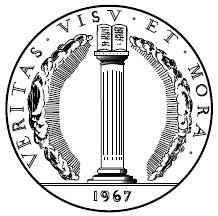 On January 8, 2011, numismatic booksellers Kolbe & Fanning will conduct a public auction sale at the Waldorf-Astoria hotel in New York City in conjunction with the New York International Numismatic Convention. The sale features 500 lots of rare and desirable works of numismatic interest, including highlights from the superb Alan Luedeking Latin American numismatic Library, classic nineteenth- and early twentieth-century works on Russian coins and medals from the library of Dr. Ira Rezak, the Dr. Jeff Hosford collection of Crosbyana, key works on ancient coins, and great classic works on American numismatics, some from the library of the New Netherlands Coin Company. Additional consignors to the sale include Norwegian numismatist Jan Olav Aamlid, Minnesota dealer Allan Davisson and the estate of the late Northern California coin dealer Robert R. Johnson. There are any number of rarities in the sale, covering the numismatic spectrum.
On January 8, 2011, numismatic booksellers Kolbe & Fanning will conduct a public auction sale at the Waldorf-Astoria hotel in New York City in conjunction with the New York International Numismatic Convention. The sale features 500 lots of rare and desirable works of numismatic interest, including highlights from the superb Alan Luedeking Latin American numismatic Library, classic nineteenth- and early twentieth-century works on Russian coins and medals from the library of Dr. Ira Rezak, the Dr. Jeff Hosford collection of Crosbyana, key works on ancient coins, and great classic works on American numismatics, some from the library of the New Netherlands Coin Company. Additional consignors to the sale include Norwegian numismatist Jan Olav Aamlid, Minnesota dealer Allan Davisson and the estate of the late Northern California coin dealer Robert R. Johnson. There are any number of rarities in the sale, covering the numismatic spectrum.
A printed catalogue may be obtained by sending $25 to: KOLBE & FANNING NUMISMATIC BOOKSELLERS LLC, 141 W JOHNSTOWN ROAD, GAHANNA OH 43230-2700. The catalogue is also accessible free of charge at Kolbe & Fanning website: www.numislit.com.
The sale features no fewer than seven original editions of Sylvester Crosby's Early Coins of America, including two from the library of the author and five other quite special copies. Other American rarities include an original 1925 Browning work on quarter dollars annotated by Walter Breen; a nice 1921 John Story Jenks sale with original photographic plates; three Eckfeldt and Du Bois works featuring actual gold examples from the California Gold Rush; a superb deluxe leather-bound set of the virtually unknown 1881 edition of Loubat's Medallic History of the United States; all three of James Mease's extremely rare 1821-1838 works on United States numismatics, the earliest works on the topic written from a numismatic perspective; B. Max Mehl's own set of Mehl's Numismatic Monthly; George Woodside's own annotated copy, with plates, of the 1892 sale catalogue of his collection of United States pattern coins; the unique and extensive numismatic archive of Chicagoan Michael A. Powills, a noted coin collector prominent in American Numismatic Association affairs and the leading numismatic book dealer of his time, containing many thousands of letters from the key movers and shakers in American numismatics, circa 1930-1980; papers relating to the Dr. John E. Wilkison collection of United States pattern gold coins; and a deluxe edition of Valentine's famed 1924 work on fractional currency, annotated by Walter Breen.
Classic works on medieval and modern coins and medals include a superb set of the 1791 Beskrivelse over Danske Mynter og Medailler from the library of the Prime Minister of Denmark, along with other classic works on Scandinavian numismatics including the extremely rare supplement to the Beskrivelse; a number of rare and important 16th- and 17th-century merchant guides, often termed “Coin Books”; several very rare works on coining technology; rarities on Scottish and English numismatics from the Allan Davisson library; the first 21 volumes of Rivista Italiana, 1888-1908; the firm's own annotated copies of over 300 Glendining & Co. auction catalogues, 1966-1986; and two leather-bound presentation volumes on Canadian numismatics written by Alfred Sandham.
Desirable works on Russian numismatics include an exceptionally fine set of the Grand-Duc Georges Michaïlovitch's 1916 Monnaies de l'Empire de Russie, from the library of Frank Sternberg; a nice complete set of the Russian edition of Chaudoir; most of the key early and mid-twentieth century auction sales of Russian coins; Hutten Czapski's very rare 1875 treatise on early Russian coins; and rare titles by Iversen, Oreshnikov, Sontsov, Count Tolstoi, and others.
Nearly 150 highlights from the Luedeking library of Latin American numismatics are featured, among them virtually all of the great classic works, including a complete run of José Toribio Medina's principal numismatic works and several minor Medinas as well; the unique bid-book of the 1878 Fonrobert Central America auction sale; 14 lots of invaluable checklists of Latin American and Caribbean tokens compiled by David Henkle; rare Meili and Alejandro Rosa works; along with various seldom-encountered periodicals and virtually complete sets of specialized auction sale catalogues on the topic.
It is the most comprehensive library on the topic ever handled by Kolbe & Fanning. The balance of the library will be sold in a Spring 2011 Kolbe & Fanning sale, as will remaining works from the Rezak library.
Key works on ancient numismatics include a complete set of Ernest Babelon's landmark Traité des Monnaies Grecques et Romaines; an original set of Eckhel's 1792–98 Doctrina Numorum Veterum in an armorial binding; the Chapman brothers annotated salesroom copy of the famous 1905 Jacob Hirsch auction sale of the Rhousopoulos collection of ancient Greek coins; a number of key antiquarian works on ancient coins; and Andreas Alföldi's exceptionally fine set of Mazzini's five-volume Monete Imperiale Romane. Inquiries may be directed to David F. Fanning at df@numislit.com, (614) 414-0855, or to George F. Kolbe at gfk@numislit.com, (909) 338-6527.
NEW EDITION: AGRICULTURAL AND MECHANICAL SOCIETY MEDALS OF THE U.S.
I would like to announce the publication of my improved 2nd edition of Agricultural and Mechanical Society Award Medals of The United States containing one thousand plus high definition medal photos. It is available for purchase at lulu.com. However, you can read the entire book for free online should you choose.
It is as good a job that I can do at this late stage of life (76). It wouldn't have been finished at all without the skills and efforts of my associate and friend Tim Corio.
To view or order the book at Lulu.com, see: Agricultural and Mechanical Society Award Medals of The United States Second Edition
To read the earlier E-Sylum articles, see:
NEW BOOK: AGRICULTURAL AND MECHANICAL SOCIETY MEDALS OF THE U.S.
(www.coinbooks.org/esylum_v12n51a05.html)
BOOK REVIEW: AGRICULTURAL AND MECHANICAL SOCIETY MEDALS OF THE U.S.
(www.coinbooks.org/esylum_v13n01a07.html)
NEW BOOK: MERCHANTS MAKING MONEY, 2011 EDITION
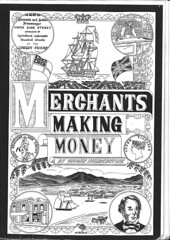 Between 1857-81, 46 firms in New Zealand issued tradesmen's tokens to alleviate the severe shortage of Imperial copper and bronze coinage. These privately issued tokens represent New Zealand's only indigenous metallic currency up to 1933.
Between 1857-81, 46 firms in New Zealand issued tradesmen's tokens to alleviate the severe shortage of Imperial copper and bronze coinage. These privately issued tokens represent New Zealand's only indigenous metallic currency up to 1933.
Merchants Making Money, 2011, represents the first attempt to gather comprehensive biographical information on the 59 issuers of New Zealand tradesmen's tokens. The 45 biographical articles included cover 51 of the token issuers, with significant information also provided on a further 6 issuers (only 2 remain completely unknown). Also covered are the 6 firms known to have struck NZ tokens.
Merchants Making Money, 2011, is 281 pages in length and is based entirely on original and fully referenced research, the vast majority of which is previously unpublished in numismatic literature. As such, this manuscript comprehensively rewrites what is known about this branch of NZ numismatics. Included are line drawings of the tokens, photographs of the token issuers and their shops, advertisements from newspapers and almanacs, 4 appendices and a 39-page bibliography.
Links with North America: Only two New Zealand token issuers are known to have set foot in North America; William Morrin (of Morrin & Co) was born at Montreal, Quebec, Canada, in 1826, and was married on 16 November 1864 at Calvary Church, buffalo, New York. Meanwhile, in the early 1880s Thomas Spencer Forsaith and his wife paid a long visit to the United States and Canada.

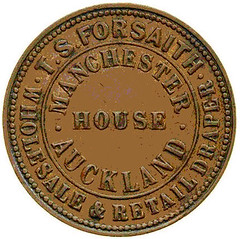
Although Merchants Making Money is unpublished, a series of articles using information from this manuscript are being published by Token Publishing Ltd in the Coin News magazine, the top-selling coin magazine in Britain (Auckland issuers, Viol. 45, No. 12, December 2008, Dunedin issuers, Vol. 47, No. 3, March 2010, Wellington issuers, forthcoming).
It is anticipated that the print run on Merchants Making Money, 2011, will be very small, if not virtually non-existent. Only a handful of earlier editions were ordered, and these all reside in research libraries.
E-Sylum readers who would like a signed copy can order from the author at vhumberstone@yahoo.co.nz at a price of $NZ30.00 per copy.
To read the earlier E-Sylum article, see: UPCOMING BOOK: MERCHANTS MAKING MONEY, 2011 EDITION (www.coinbooks.org/esylum_v13n32a05.html)
BOOK REVIEW: THE ENCYCLOPEDIA OF ROMAN IMPERIAL COINS, SECOND EDITION
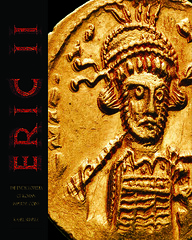 When I first became interested in the Roman imperial coinage, I – like many before me – initially turned to David Van Meter's “Handbook of Roman Imperial Coins” and the 4th edition of David Sear's “Roman Coins and their values” (RCV) to help me attribute and catalog the coins that I began to acquire. Each is a single-volume reference that provides the level of information that a beginner needs to start collecting in this area.
When I first became interested in the Roman imperial coinage, I – like many before me – initially turned to David Van Meter's “Handbook of Roman Imperial Coins” and the 4th edition of David Sear's “Roman Coins and their values” (RCV) to help me attribute and catalog the coins that I began to acquire. Each is a single-volume reference that provides the level of information that a beginner needs to start collecting in this area.
Of course you pay a price for trying to collapse five centuries of coinage into a single compact volume: only a small subset of the vast coinage can be included. As the collector becomes more advanced and begins to acquire a broader range of material, more inclusive references are required.
Sear recognized this more than a decade ago, and launched the Millennium Edition revision of RCV. However, what was once a single volume has expanded to five, two of which are yet to be published.
For decades, the gold standard for comprehensive coverage of the Roman imperial period has been “The Roman Imperial Coinage” (RIC), a massive 10-volume reference published over many years beginning in the 1920s. In addition to being far larger than a single volume, much of the data in RIC has been superseded by more recent scholarship and additional reference material must often be consulted.
So is it possible to cover the Roman imperial coinage in a single, comprehensive, up-to-date volume? This is the question that Rasiel Suarez sought to answer when he first published “The Encyclopedia of Roman Imperial Coins” (ERIC) in 2005. Although ERIC I did not quite get there in terms of completeness, I believe that the newly revised ERIC II hits the mark.
What I like the most about ERIC (both I and II) is the focus on the needs of the collector as opposed to the numismatic researcher. This collector-oriented focus is most evident in the way that Suarez has organized his material and the shorthand that he developed to express the listings.
RIC was written by numismatic scholars and is organized to reflect how the coinage evolved over time. While this level of information is extremely important, it can make it difficult for the average collector to locate the listing for a given coin. I have found this to be especially true for more obscure issuers and for types that were issued intermittently over a broad span of years.
Suarez deliberately sacrifices the scholarship of RIC in order to deliver a system for quickly locating and attributing any given Roman imperial coin. The material in ERIC is organized by ruler, bust, obverse and reverse legend, reverse type and mint, and the shorthand used in the catalog makes it easy to match a coin with its listing – even if some of the information is unavailable due to poor coin quality or legends that run off-flan. This shorthand also allows for a significant number of listings to be included in a reasonable amount of space.
Suarez has also put a great deal of effort into providing an extensive set of high-quality, full-color photographic plates that illustrate the variety of obverse busts and reverse types associated with each issuer. This is a very useful attribution tool, and anyone accustomed to working with the RIC plates (especially the photographic reprints) will appreciate the breadth, organization and quality of the images in ERIC.
I would recommend ERIC as a compliment, not a replacement, to other references. You'll probably still want Van Meter or the 4th Edition of RCV on hand to toss in your bag for coin shows or club meetings: at 10 lbs, ERIC II is not exactly portable! I will often take RCV to a club meeting to work out rough attributions, then fine-tune when I'm back home. I have also been keeping up with the Millennium Edition of RCV because the value data is more granular that what you will find elsewhere. And of course, nothing beats RIC for understanding the historical context of your collection. I keep all of these references on hand, including ERIC, because they each serve a specific need.
ERIC II is a smart addition to your numismatic library for its single-volume completeness, collector-friendly catalog, and fabulous plates.
To read the earlier E-Sylum articles, see:
NEW BOOK: THE ENCYCLOPEDIA OF ROMAN IMPERIAL COINS, SECOND EDITION
(www.coinbooks.org/esylum_v13n33a03.html)
ENCYCLOPEDIA OF ROMAN IMPERIAL COINS HIGHLY SOUGHT
(www.coinbooks.org/esylum_v13n41a08.html)
THE BOOK BAZARRE
PRINCETON 'MONEY ON PAPER' EXHIBIT LECTURE DECEMBER 12, 2010
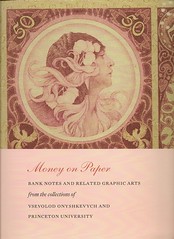 The final Curatorial Tour of the exhibit Money on Paper at Princeton University will be held on Sunday, December 12, at 3 p.m. in Firestone Library's Milberg Exhibition Hall. Curator Alan Stahl will discuss the highlights of the exhibit, including an extensive series of Benjamin Franklin's nature print notes; signed notes by the painter Asher B. Durand and his brother Cyrus; Princeton's complete set of Montgomery and Richmond Confederate notes; the first public showing of John James Audubon's grouse vignette; as well as modern banknotes by artists such as Alphons Mucha.
The final Curatorial Tour of the exhibit Money on Paper at Princeton University will be held on Sunday, December 12, at 3 p.m. in Firestone Library's Milberg Exhibition Hall. Curator Alan Stahl will discuss the highlights of the exhibit, including an extensive series of Benjamin Franklin's nature print notes; signed notes by the painter Asher B. Durand and his brother Cyrus; Princeton's complete set of Montgomery and Richmond Confederate notes; the first public showing of John James Audubon's grouse vignette; as well as modern banknotes by artists such as Alphons Mucha.
The exhibit will run through January 2: Mondays through Fridays 9 to 5, Saturdays and Sundays noon to 5 (closed on Dec. 24 and 25; Dec. 31 and Jan. 1). Further information to the tour and exhibit are available at www.princeton.edu/~rbsc/department/numismatics/exhibits.html or from astahl@princeton.edu.

To read the earlier E-Sylum articles, see:
NEW BOOK AND EXHIBIT: MONEY ON PAPER
(www.coinbooks.org/esylum_v13n34a07.html)
PRINCETON 'MONEY ON PAPER' EXHIBIT LECTURE AND RECEPTION HELD
(www.coinbooks.org/esylum_v13n44a10.html)
MORE ON THE WHITMAN 'VAULT' BOOKS
The Whitman Vault Books have been around for a few years. The first Vault Book was for the University of Tennessee, because someone high up in Whitman is a Tennessee graduate. The second was for the University of Georgia--which I own as an alumnus of Georgia. The Vault Books are very interesting in that they use replica souvenirs to help tell the story. Depending on the subject of the book, the type of replica souvenirs can be anything, including numismatic items.
For the UGA book, Whitman hired Loran Smith, a legendary broadcaster for Georgia (the sideline reporter to the play-by-play man, the legendary Larry Munson), who has written other books about Georgia Football. The execution is very entertaining and really is like looking into the past. I was very impressed as to how the book was done and would love to see them do vault books for more than just college football and basketball.
If you did not notice, Whitman is expanding their offerings from coins and stamps with books on other types of collectibles. I know many of your readers like paper, but Whitman is going to have to find a way to enter the digital age. Maybe they can look to their competition at Krause for one way to do this.
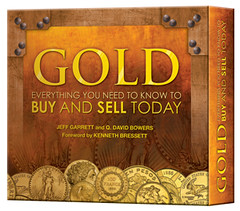

Above are images of a couple of the 'Vault'-style books, including the Gold book. You know, that picture of Sarah Palin looks like my old girlfriend, Jungle Judy... -Editor
To read the earlier E-Sylum article, see: NUMISMATIC CONTENT IN WHITMAN'S PALIN “COLLECTOR'S VAULT” BOOK (www.coinbooks.org/esylum_v13n47a03.html)
NUMISMATIC VOCABULARY: ANAGLYPTOGRAPHY
The technology that Ken Bressett alluded to in his response on the use of electrotype process in last week's E-Sylum has a name. That name is anaglyptography. It is the use of a small glyptic object -- medals, seals and cameos made ideal patterns -- whose surface is copied by a device that transfers the object's modulated relief surface to line drawings of two dimensions that indicate the rise and fall of the design.
Most amazing of all, it was invented by -- hold on to your keyboard Dear Reader -- Christian Gobrecht, who later became Chief Engraver at the Philadelphia Mint. As a young man of 29 in 1817 Gobrecht took up watch engraving, creating the decorative lines engraved on watch cases. Eight years later, in 1825, he invented a primitive anaglyptographic device. It could draw lines, or engrave lines like his watch case engraving.
It was based on a ruling machine - it would draw a straight line, advance a preset distance and draw another straight line. Gobrecht's inventive mind realized that if he had a pattern that a tracer could control, the straight lines could be slightly curved according to the rise and fall of the relief on the pattern. He had to manually move the tracer a very small distance to start the next path across the pattern's surface. With his early device he advanced this distance only a couple dozen lines per inch.
But the end drawing was something close to an illustration of that object. It was somewhat like a tiny topographical map of that surface. Gobrecht had a fellow Philadelphian, machinist Joseph Saxton (who also would later be employed at the Philadelphia Mint as a builder of scales) build him an improved model of the device.
Saxton took a trip to London in 1829, taking one of Gobrecht's inventions with him. He improved on it there and sold one of these devices to a gentleman in London. Saxton returns to America. The gentleman dies and the machine is acquired by a technician in London, John Bate. Bate makes a slight improvement and obtains a British patent -- number 6254 -- claiming he was the inventor.
Completely independent of all this and without any knowledge of Gobrecht's invention, the same kind of device is invented in Paris by a French mechanic, Achille Collas. Collas builds a device so advanced it could draw 200 lines to the inch! French businessman Vincent Nolte learns of Collas device and foresees the commercial possibilities of such a device. It could illustrate books with these close-line drawings of small glyptic objects -- medals, seals and cameos. [Remember, this was before photography was invented and book illustrations had to be printed from hand engraved plates.]
Nolte bought the rights to the device and hired Collas to operate his machines. Nolte then approached a Paris publisher, Alexander de Lachevardiere, and enticed him into a venture of publishing books illustrated with anaglyptographic engravings. Nolte gathered medals, seals and cameos and Collas made patterns of these. The patterns were mounted in his device and set in motion. His device etches lines in an engraver's plate that can be used to print sheets for a book.
In 1834 the company, Lachevardiere & Cie, launches one of the most ambitious undertaking in numismatic publishing -- Tresor de Numismatique et de Glyptique. Nolte gathers medals, seals and cameos -- or their plaster casts -- from all over Europe. With Collas operating his engraving machines they created and published four folio pages and one page of text each week. An astounding enterprise, this process was to continue for 24 years, publishing 20 large folio volumes!
Two years later, in 1836, Nolte travels to London in search of more small glyptic objects. He goes to the British Museum searching for medals and is introduced to Edward Hawkins, an assistant curator. Prophetically, Hawkins has in hand, a manuscript on the medals of Great Britain. What an ideal publication, Nolte notes, to illustrate with Collas' engravings!
With Hawkins approval, Nolte sets out to find a British publisher. He does - Charles Tilt agrees to finance and publish the work. They set about making plaster copies of the British medals to send to Collas in Paris. John Bate learns of this project and brings suit to halt the work. He objects to a foreigner making the plates on a device for which he holds the British patent.
Since the book would be a British Museum publication it came under the jurisdiction of the British Parliament. Each side lined up their allies and experts to give testimony. Nolte enlisted the aid of prominent medalist William Wyon, even making drawings of several of Wyon's own medals to illustrate the mastery of Collas work. Wyon agrees to testify for Nolte against Bate.
At the trial however, Wyon switched his testimony in favor of Bate and Nolte lost. The upshot was that Hawkins manuscript was not published by either party. His manuscript was finally published in 1885, seventeen years after the author's death. And the illustrations? They weren't published until 1904-11, an astounding 68 years after Vincent Nolte wanted to publish the work with plates engraved by Achille Collas!
All because an illegitimate British patent holder didn't want a foreigner to engrave the printing plates!
But that is not the end of the story. Back in America banknote engraver Asa Spencer learned of Gobrecht's invention and obtained one of the machines built by Joseph Saxton. Other banknote engravers -- James W. Steel and Waterman Lilly Ormsby -- learned from Spencer about the Saxton's magical machine that engraves images. These banknote engravers made use of the machine for engraving small vignettes for use on American paper money.
Also -- and here is where Ken Bressett's mention enters the story -- in the early 1840s Joseph Saxton goes to work at the Philadelphia Mint. While Gobrecht is still alive (he didn't die until 1844) U.S. Mint Assayers Jacob B. Eckfeldt and William E. DuBois use one of the Saxton-built machines to engrave illustrations for their two books, published in 1842 and 1846.
I like to think Christian Gobrecht was looking over their shoulders while they were etching those illustrations. Perhaps he even set up the device himself. Saxton had introduced steam power to it to automatically advance a tiny distance after each row is traced and transcribed. It did not have to be manually advanced.
Plaster casts were first used for the machine's patterns. In January 1842 Franklin Peale brings to the Philadelphia Mint the technology of electrolysis. He made an electrogalvanic cast of the plaster model of the Anthony Wayne Stony Point Medal (Julian MI-31). This was used on the mint's Contamin reducing lathe (acquired 1835) to cut a portrait punch. Could they use the same technology to make electrotypes of coins and medals for use as patterns for their anaglyptograph?
Yes indeed! Further, a positive medal made a negative electrotype. And a negative electrotype made a better pattern for the tracing. Also, making an electrotype did not damage the original where a tracing stylus might. Thus DuBois had electrotypes made of U.S. Mint specimens and these were used as patterns for making anaglyptographic illustrations for their two books.
This printing process served well in mid-19th century. But it was overcome by the invention of photography and photoengraving. By 1880 it was no longer useful. But numismatic book collectors have in their libraries specimens of this kind of illustration process.
MORE ON FRENCH-ENGLISH NUMISMATIC TERMS
I read in the recent E-Sylum that folks working with you on upgrading the Gadoury French coin guides were at times looking for English equivalents of certain French numismatic terms. I am not certain if you are aware, but there is an existing publication that may be of interest, and may resolve some of the difficulties. Although coming from a Canadian perspective, Serge Pelletier's publication, The Canadian Dictionary of Numismatics / Le dictionnaire Canadien de numismatique would probably address most English-French terms. The 264pp soft cover publication is also available for biliophiles in a limited issue, hard bound version with a CD-ROM.
Serge Pelletier writes:
In addition to including Canadian terms, my dictionary also includes term related to Ancient and general numismatics as well as that of France, United States and United Kingdom.
Mark adds:
The response from my NBS query was simply overwhelming! Besides Serge Pelletier, I would like to extend my sincere thanks to William Waychison, David Gladfelter, Hadrien Rambach, Tony Hine, Martin Kaplan and Robert Laviana for their valuable time and excellent suggestions. Their interest in helping me to translate French-English numismatic terms reveals a real need for this sort of information.
Tony Hine's suggestion of publishing an article on French-English numismatic terms in both The Numismatist and the Canadian Numismatic Journal was especially noteworthy. It is an idea I am going to seriously consider after I complete a few other articles.
I will try to keep the NBS updated on this and Pelletier/Taillard's numismatic lexicon for Editions Gadoury, which will be for one and not two books as I had previously gathered. M. Taillard informed me that it will be on French essais, prototypes, pieforts, etc, struck from 1872-2001.
Serge Pelletier has replaced me on the French-English numismatic lexicon for Editions Gadoury. I may take up Mr. Hine's suggestion and publish a separate list of translated terms for the The Numismatist and/or the Canadian Numismatic Journal when more time permits. To accomplish that, I will still need some guidance and my work critiqued by others, so I am very grateful to all of those who responded to my E-Sylum query! Until then...
To read the earlier E-Sylum article, see: QUERY: FRENCH-ENGLISH NUMISMATIC TERMS TRANSLATION REVIEW SOUGHT (www.coinbooks.org/esylum_v13n47a09.html)
MORE ON THE LOVETT TOKENS AND MEDALS WEB SITE
I am not quite sure whether to thank John Sallay or not for notifying the E-sylum readers of the launch of my new website! I took Dick Johnson's advice not to wait till it was complete before putting it on the web so there is a lot of work to do. I did sort of a 'soft launch' by sending out to a few individuals. But it is out there now; and I do appreciate John's effort to let everyone know about it.
I am looking forward to hearing from anyone about the site and their comments and critiques. I am no researcher and definitely not a computer expert. So please let me know if you see problems with the site (which I usually catch myself) or factual errors. Currently I am putting up images of pieces from my own collection but hope to be able to solicit images from others and ultimately be able to list all the works of Robert Sr. and his sons. This is an ambitious project! And one which I hope will lead to a catalog of their works.
I am also very open to anyone who would like to contribute to the site. If you have some information/research that may not be conducive to an entire article but would like to share it with the numismatic community I would love to include it, with proper credit given of course. Katie Jaeger will be doing the biographical sketches so keep an eye out for that. And I have already had several emails on suggestions where to find information.
So please take time to look at it occasionally. Hope you enjoy it is much as I have.
To visit the web site, see: lovetttokensmedals.com
On a related note Rick Stroman writes:
I thought this article might be of interest concerning the two recent articles, one on the Lovetts (medal makers) and the other on the Western Pennsylvania Numismatic Society. This was taken from the Coin Collector's Journal November, 1878 issue.
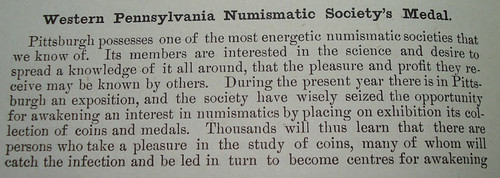
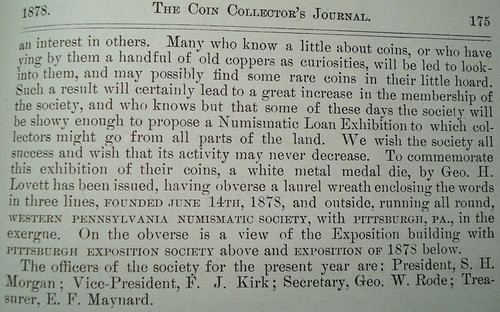
To read the earlier E-Sylum article, see: FEATURED WEB SITE: LOVETT TOKENS AND MEDALS (www.coinbooks.org/esylum_v13n47a27.html)
ADELPHI UNIVERSITY NUMISMATIC PROGRAM BROCHURE
A few weeks ago there was a discussion in The E-Sylum about the numismatic program that was once offered at Adelphi University. While moving part of my library from one room to another, I came across an original brochure of The Institute of Numismatic and Philatelic Studies of Adelphi University, Division of Special Programs. I've scanned the brochure. Perhaps I need to relocate my library more often.
To view the complete brochure, see: Adelphi University Numismatic Program brochure (www.flickr.com/photos/coinbooks/sets/72157625355027775/show/)
To read the earlier E-Sylum article, see:
STANLEY APFELBAUM, FIRST COINVESTORS AND ADELPHI
(www.coinbooks.org/esylum_v13n40a15.html)
LOUIS ELIASBERG AND THE STACK'S H.R. LEE SALE
 I would like to add to the discussion on Louis Eliasberg, and specifically the H.R. Lee collection.
I would like to add to the discussion on Louis Eliasberg, and specifically the H.R. Lee collection.
First, I would like to add a thank you to Q. David Bowers for fueling my personal interest in learning more about Eliasberg and his collection. Over the years, I have learned quite a bit from his works, and so much from other notes and material he has shared on LEE, and Clapp. It was after reading his book on Louis Eliasberg that I obtained a catalog of the H.R. Lee Collection!
My interest in Louis Eliasberg and his collection began when as a 15 year old, I visited the Smithsonian Exhibit during the Bicentennial Celebration in 1976. I can still recall the entrance door at the museum which referenced the collection, and my amazement with the collection on display. This was the first of many memorable trips to the Smithsonian over the years.
Another thanks to Harvey Stack, and Stack's as I visited his shop while in town for a press event in New York City in the 1990's, after having been dormant in collecting pursuits for many years . The state quarters program which he championed, has brought so many new people into the hobby.
This visit began to rekindle my interest, and I can remember receiving the 1996 auction catalog as a result of this visit and a brief discussion at the gallery.
I am enclosing a scan of the H.R. Lee Gold Collection Catalog, which Stack's sold October 2, 3,and 4 of 1947, not 1949. Noted in the catalog are a 1894-S dime and an 1875 Three Dollar Gold piece.
To read the earlier E-Sylum article, see: MORE ON THE COMPLETENESS OF LOUIS ELIASBERG'S U.S. COIN COLLECTION (www.coinbooks.org/esylum_v13n47a16.html)
Saul Teichman writes:
With regard to the Eliasberg completion discussion, I was also told that story about the 1866-S double eagle by Dave Bowers.
To me the most glaring omission in the collection was an 1839 Type 2 eagle.
What is surprising tome is that Eliasberg kept Clapp's patterns, an area he made no attempt to add to.
As for the selling of his duplicates, in many cases Stack's sold the higher graded coin. It would be interesting to hear from Harvey as to the agreement Stacks made with Eliasberg regarding this.
Nick Graver writes:
I realized that not many readers would have known Louis Eliasberg. You could run a picture from that Baltimore newspaper showing him with his collection in front of the vault door. Where else might readers ever see him?
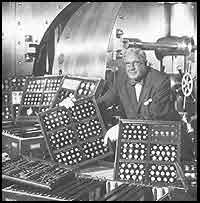
MORE ON VIETNAMESE NGOC HA GOLD WAFERS
Greg Anglin writes:
I was a Marine in Vietnam 1969-70. One day, I was in a local market in Danang, and a Vietnamese civilian next to me pulled out a roll of thin gold foil & proceeded to cut off a piece to pay for an item. I was fascinated by this & never forgot it. Howard Daniel's article in The E-Sylum is the first mention of this I have ever seen or heard of since I left that lovely climate many years ago. I recall the roll of gold foil was (loosely rolled) about 1 inch in diameter.

To read the earlier E-Sylum article, see: QUERY: VIETNAMESE NGOC HA GOLD WAFERS (www.coinbooks.org/esylum_v13n47a13.html)
NOTES FROM E-SYLUM READERS: NOVEMBER 28, 2010
Regarding Luke Griffin's search for someone making ancient coin replicas using contemporary minting techniques, Joe Boling writes:
Have you talked to the guys at the Badger Mint? That's George Cuhaj and Joe Paonessa. They run a mint at the ANA summer seminar these days, and Joe has built a great competitive exhibit showing the process, from die making through striking and finishing the coins - using first century technology.
To read the earlier E-Sylum article, see: QUERY: ANCIENT COIN REPLICA MAKER SOUGHT (www.coinbooks.org/esylum_v13n47a14.html)
Regarding Katie Jaeger's request for a copy of Thomas L. Elder's 87th Public Auction Sale, Tom DeLorey writes:
The ANA Library had most of the Elder catalogues in its collection when I researched my Elder article back in 1979.
To read the earlier E-Sylum article, see: QUERY: ELDER'S 87TH PUBLIC AUCTION SALE CATALOG SOUGHT (www.coinbooks.org/esylum_v13n47a10.html)
Joe Boling writes:
I am on the road this week with no references available, but surely Dick Johnson meant 3.11 grams, not 3.11 grains, for the weight of a wheatie.
To read the earlier E-Sylum article, see: WHAT'S A QUARTER TON OF WHEATIES WORTH? (www.coinbooks.org/esylum_v13n47a20.html)
Joe adds:
Unless Mr. Colt's family had new indoor plumbing obviating their use of the locale in which he was found four months deceased, I have to assume that outhouse in this case means out-building. Or did they have a men's and a women's loo, with the kids using Mom's facility?
To read the earlier E-Sylum article, see: GEORGE O. COLT: THE DIESINKER WHO DIED IN THE OUTHOUSE (www.coinbooks.org/esylum_v13n47a26.html)
Bob Neale writes:
Regarding cut-out coins, you might (or might not) recall that was quite the fad around the 1970s. I acquired three such items back then as pendants (not pins) for my wife. One was a Franklin half, with the Liberty Bell swinging from its support. Another was the eagle from a Peace Dollar. And my favorite: a dramatic Walker half featuring the lettering, figure of Liberty, and rays all separated from the background. These were very well done, and not the least bit fragile. And I haven't encountered such items for a great many years. I wonder whether folks still do such amazing cut-outs for sale?
To read the earlier E-Sylum article, see: MORE ON THE CUTOUT ISABELLA QUARTER PIN (www.coinbooks.org/esylum_v13n47a11.html)
QUERY: TRANSFERRING AUDIO FROM MAGNETOPHONE RECORDINGS
Dave Bowers writes:
Here is perhaps the most unusual question of the week: Jim Ruddy was secretary of the Professional Numismatists Guild in the early 1960s. I have a couple of magnetophone wire recorder recordings, one of the PNG meeting in 1963. These are on reels marked “Protono Minifon P55” and also “S120/L180.”
Question: Does anyone have equipment to transfer these to, say, CD?
QUERY: SABINE PASS MEDAL COPIES
I would like some help on a very interesting Civil War collectible. This medal is a copy (I believe) of the rare Davis Guard medals issued to the 45 Confederate soldiers who defeated the Union army at Sabine Pass, Texas.
This medal was issued to "M. Powers" (Maurice Powers), one of the soldiers. The script for the soldier's name and the rest of the writing is the same. This is another reason I believe that the medal is a copy, along with the fact that it is not silver. It is very nicely engraved, and does appear to be quite old. I listed this originally on eBay (item # 380287688740) without knowing what it was. I even misread the words, and listed it with incorrect spelling! It closed for $687.88, and within an hour, I had another offer for $1000.00. At that point, I canceled the transaction, realizing that I had something quite scarce.
Is this in fact a copy? Any help or advice would certainly be appreciated!


Lloyd Wagner example
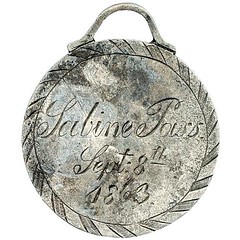
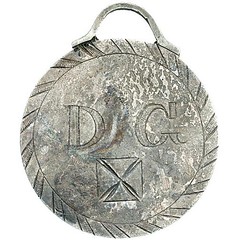
Stack's January 16, 2007 sale example (lot 6852)
To read the complete auction lot description, see: 1863 Davis Guards Medal. EF (www.stacks.com/Lot/ItemDetail/118105)
THE BOOK BAZARRE
“Sometimes All That Glitters IS Gold.”THE WHERE'S GEORGE VIKING SHIP
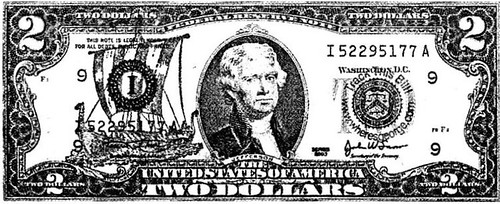
I read with interest your latest article on the 'Where's George' phenomenon and had to reply.
Around 1999 I began using the Where's George website to promote the fact that the Vikings discovered America around 1000AD. I stamped my bills with a Viking ship as well as the Where's George information. Over the years, these Viking ship/ Where's George bills have been mentioned twice in Numismatic News. The first time was in the form of a letter to the editor on December 19, 2000 and the second was a photo of a $2 on April 10, 2007.
My favorite 'hit' for one of my Georgies was a few years ago when, in the remarks section of the found bill, someone wrote, "Received in change from a smoke shop in downtown Baghdad"!
There are a million ways to have fun with the hobby and Where's George is only one of them.
To read the earlier E-Sylum article, see: SO THAT'S WHERE GEORGE IS: FORT LAUDERDALE, FL (www.coinbooks.org/esylum_v13n47a25.html)
NEW COINS FROM LATVIA AND FRANCE

P.K. Saha writes:
Latvia has issued a coin containing a small piece of amber. The coin was issued on Nov. 15. The coin has a face value of 1 lat.
To read the complete article, see: National Coin Programmes (www.bank.lv/eng/main/all/lvnaud/jubmon/nmp/)
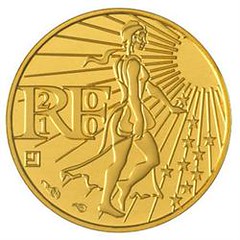
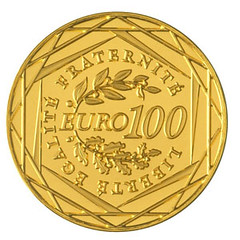
P.K. Saha writes:
France has issued 100 Euro circulating coin. It is being issued at face value hence it can be truly called a circulation coin.
From the web page:
- Mint: Monnaie de Paris
- Denomination: €100
- Quality: Uncirculated
- Issue limit: 50,000 pcs.
- Alloy: 99.9% Fine Gold
- Diameter: 15 mm = 0.59 in
- Weight: 3.10 grams = 0.108 oz
This is the third and last year for an innovative concept: renewing usage of precious metals as circulation coins. This tradition was started in 1960 with the silver 5 Franc coin, and was abandoned with the demise of the Franc.
Distributed in France by the Post Office (La Poste), and sold at face value in order to promote circulation, this series incorporates French monetary tradition and honors the values of sovereignty, nation and citizenship.
Its innovative design unites tradition and modernism: on the obverse “The Sower” - a symbol of French monetary history - is reinterpreted in a contemporary version. Moving for the first time in her history, she evolves in a kinetic manner through the 8 denominations (three in 2010) as she sows stars. On the reverse, a spatial interpretation of the French hexagon surrounding a Euro sign made of branches of oak and laurel.
To read the complete article, see: 2010 France €100 Gold Circulating Coin (rsmint.com/2010franceandeuro100goldcirculatingcoin.aspx)
ARTICLE HIGHLIGHTS RARE OXFORD 1066 PENNY
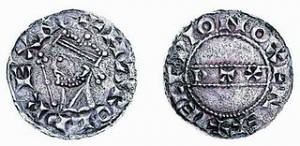
A rare coin made in Oxford in or around 1066 – the year of the Battle of Hastings – is set to fetch up to £1,500 at an auction next month.
The 1,000 year-old silver penny was made in Oxford by a so-called moneyer named Aelfwig during the 10-month reign (January 5,1066, to October 14 1066) of King Harold II. Harold was killed after being shot in the eye with an arrow at the Battle of Hastings, which was won by William The Conqueror on October 14,1066, and which is recorded on the Bayeux Tapestry.
Richard Bishop, head of the coins department at Spink in London, says the Oxford penny is “super rare.” In fact, it is so rare that only seven other Harold II pennies from Oxford are known to have survived. Some of these are now owned by museums – including three at the Ashmolean, in Oxford .
Only a handful are in private hands.
Mr Bishop said: “Harold II pennies are very collectable because of the shortness of the reign.
The Oxford penny coming up for sale at Spink in Bloomsbury, London, on December 2, was found in the ground, but where, how and by whom is not known.
But even though it was buried for nearly a 1,000 years, the coin is described as being in “good, very fine condition.” The coin features the tell-tale letters “OXEN” and also features an image of King Harold, with a sceptre.
To read the complete article, see:
Rare Oxford 1066 penny goes under the hammer
(www.oxfordmail.co.uk/news/yourtown/oxford/8679390
.Rare_Oxford_1066_penny_goes_under_the_hammer/)
MORE ON THE FORGED ROMAN SILVER DENARIUS
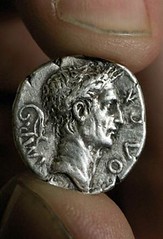 Roman coin discovered by a cleaner was struck at the time of Christ by a forger who couldn't spell and didn't know one emperor from another.
Roman coin discovered by a cleaner was struck at the time of Christ by a forger who couldn't spell and didn't know one emperor from another.
Experts at the British Museum say the coin is a mystery because it is made from solid silver and probably cost the forger as much to make as he received in profit.
The silver denarius, an average day's pay for a Roman worker, is based on coins struck to commemorate the Battle of Actium between Octavian and the combined forces of Mark Antony and Cleopatra in 31 BC.
But the forger got most of his inscriptions wrong. He crafted his denarius some years after the battle but had a poor memory of what the real coin looked like. On one side is a crocodile but it is facing the wrong way. On the other side is the head of Julius Caesar when it should have been the his nephew the Emperor Augustus.
An examination using the university's new state-of-the-art electron microscope, the most advanced in the south east, showed the coin's content is solid silver. Rob registered the find with Laura Burnett, finds liaison officer for Sussex, who sent photos of the coin to the British Museum.
Sam Moorhead, national finds adviser for Ancient Coins at the British Museum, said the poor spelling "suggests the die cutter is not fully literate" and he said he was baffled why the forger bothered in the first place.
He said: "Interpreting the coin is difficult. Were it a (silver) plated piece, then it would have been explicable as an attempt to create a coin for profit by using a smaller amount of silver.
"However, why would someone create a fantasy piece like this in the ancient period from solid silver? As such, the coin is a mystery."
However Diarmaid Walshe a PhD researcher at the nearby University of Sussex has a theory, "Could we be looking at early form of money laundering?". Its possible the forger had come into the possession of sliver which might have been acquired illegitimately and the forger wanted to hide this. A classic way to convert hot or stolen property is to use methods that can clean it up and so camouflages its illegal origins. By converting the metal into coin form it would have in todays terms, "laundered it" and would have made it difficult to have traced it original source. In this way forger could have used the coins as currency which goes some way to to explain the mystery"
To read the complete article, see:
The mystery of a forged coin and money laundering?
(www.archnews.co.uk/featured/3859-the-mystery
-of-a-forged-coin-and-money-laundering.html)
To read the earlier E-Sylum article, see: METAL DETECTORIST FINDS UNUSUAL COUNTERFEIT ROMAN COIN (www.coinbooks.org/esylum_v13n45a19.html)
MILITARY WIDOW SAYS HUSBAND'S MEDALS WERE CREMATED
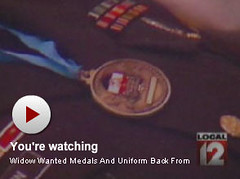 An Army widow wants her husband's uniform and medals. He was cremated more than a year ago but she still has not received them back from the funeral home. She says she's asked why, but hasn't received any answers. So she turned to Local 12 Troubleshooter Howard Ain for help.
An Army widow wants her husband's uniform and medals. He was cremated more than a year ago but she still has not received them back from the funeral home. She says she's asked why, but hasn't received any answers. So she turned to Local 12 Troubleshooter Howard Ain for help.
Tyanne Martin of Fairfield says she's been trying to get back her husband's belongings ever since he was cremated in September last year. Staff Sergeant James Martin Junior was a highly decorated Iraqi War veteran.
The cancer developed just as Martin was on his second tour of duty in Iraq. Previously, he had received the Audie Murphy Award for leadership achievement and performance... an award that was around his neck at his funeral-- immediately prior to his cremation. "The whole agreement was for my husband to have the funeral and I gave the funeral home all of his military awards and medals plus his uniform and it was the only one I had left."
Martin says she told the funeral home numerous times, "I wanted my stuff back. I mean why would I want a rare military award cremated? Who would do that?"
After the funeral the Thompson, Hall and Jordan Funeral Home gave her the cremated remains and pictures-- but neither the award nor uniform. "They kept saying they were going to give me my uniform and kept saying give us a couple of days we'll give it to you."
I contacted Katherine Jordan of Thompson, Hall and Jordan funeral home. She checked and found everything was cremated because of a mistake. Jordan says she didn't have Mrs. Martin's correct phone number until I gave it to her. She called and apologized and offered to forgive the $4500 still owed on the funeral.
To prevent this type of thing from happening to you, make sure the cremation form states everything you wish to be returned. Although Mrs. Martin says she told this to several people, nothing was ever put on that form.
To read the complete article, see:
Military Widow Says Husband's Medal Was Cremated
(www.local12.com/news/local/story/Military-Widow-Says
-Husbands-Medal-Was-Cremated/V2rKRonPdUSH2EcTWmhVBA.cspx)
READER CRACKS BOOK'S RIDDLE, LOCATES HIDDEN COIN
 When author Christopher Marsh wrote a riddle into his novel he was certain it would never be solved. But now a Belfast reader has unlocked the complex code 18 months after the book, A Year In The Province, was published.
When author Christopher Marsh wrote a riddle into his novel he was certain it would never be solved. But now a Belfast reader has unlocked the complex code 18 months after the book, A Year In The Province, was published.
The exact co-ordinates of where a Spanish medieval coin was hidden were buried in a complicated set of clues scattered through the story of Jesus Sanchez Ventura, who swaps the orange groves of Andalucia for Orangemen of Belfast.
David McNeill and his wife Sheila recently made the trip to Rathlin Island where they found the ancient coin placed in a hole within an internal wall of the ruined house at Rue Point, the southernmost tip of the island.
“I read it over the summer; my wife read it first and suggested I might find it funny. It was quite humourous and quite outrageous in places, but it was really the riddle I was interested in,” he said.
He had a hunch the secret coin might be on Rathlin as the riddle hinted at geographical coordinates matching the area.
They found the coin tucked behind a loose stone in the corner of the ruined building.
But the Belfast man does not want to keep it. “I think I am going to try to return it so maybe Mr Marsh could be inspired to write another book.”
Author Marsh, a history lecturer at Queen's University Belfast, was amazed that the riddle had been solved.
“In order to crack it, they had to find their way through a forest of anagrams, rhymes, map coordinates and other cryptic verbal clues.
“Then they had to use a map or satnav to pinpoint the location — I think they did it with a map — and travel there in order to unravel the last parts of the riddle. They must have walked the three miles from the harbour, almost certainly in high winds. I'm amazed that anybody found the coin at all,” he said.
The McNeills must take it now to Conor Cafe in Belfast, where they can claim a fee meal for two “and a fine bottle of Bushmills that I had assumed I might end up drinking myself,” said Mr Marsh. Manus McCann of Conor Cafe said he agreed to provide the prize after speaking with the author about his book. Staff are now waiting for Mr McNeill to come in for his meal and drink. He is delighted to be giving away the vintage whiskey.
“I didn't believe that it would be solved at all, the bottle of whiskey was almost getting in the way in the stock room. Hopefully he won't be waiting as long to claim his meal as the bottle has been waiting here with us,” he said.
To read the complete article, see:
David coining it in after cracking novel code
(www.belfasttelegraph.co.uk/news/local-national/
northern-ireland/david-coining-it-in-after-cracking-novel-code-15011118.html)
FEATURED WEB SITE: PAPER MONEY OF ENGLAND AND WALES
This week's Featured Web Site is Paper money of England and Wales, part of the British Museum's online research catalogue collection.
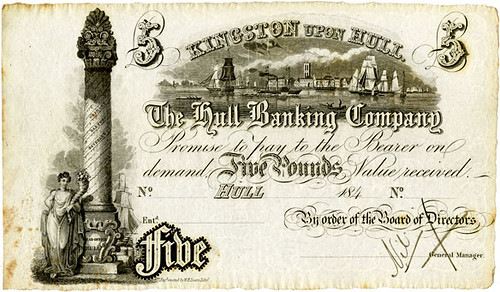
This catalogue brings together the British Museum's collection of paper money from England and Wales, including banknotes and cheques.
This publication includes a total of 1,868 objects, but the catalogue will grow over time and will be added to until it includes the Museum's entire collection of almost 10,000 pieces of English and Welsh paper money, including cheques.
www.britishmuseum.org/system_pages/
holding_area/research/paper_money/
paper_money_of_england__wales.aspx

